.gif)
Trainer (aircraft)
Encyclopedia
A trainer is a class of aircraft
designed specifically to facilitate in-flight training
of pilots and aircrews. The use of a dedicated trainer aircraft with additional safety features—such as tandem flight controls, forgiving flight characteristics and a simplified cockpit arrangement—allows pilots-in-training to safely advance their real-time piloting, navigation and/or warfighting skills without the danger of overextending their abilities alone in a fully featured aircraft.
Civilian pilots are normally trained in a light aircraft, with 2 or more seats to allow for student and instructor. The aircraft may be modified to withstand the flight conditions imposed by training flights.
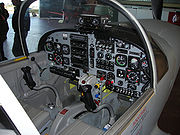 The two seating configurations for trainer aircraft are pilot and instructor side by side or in tandem, usually with the pilot in front and the instructor behind. The side-by-side seating configuration has the advantage that pilot and instructor can see each others actions, allowing the pilot to learn from the instructor and the instructor to correct the student pilot. The tandem configuration has the advantage of being closer to the normal working environment that a fast jet pilot is likely to encounter.
The two seating configurations for trainer aircraft are pilot and instructor side by side or in tandem, usually with the pilot in front and the instructor behind. The side-by-side seating configuration has the advantage that pilot and instructor can see each others actions, allowing the pilot to learn from the instructor and the instructor to correct the student pilot. The tandem configuration has the advantage of being closer to the normal working environment that a fast jet pilot is likely to encounter.
It is now the norm for pilots to begin their flight training in an aircraft with side by side seating and to progress to aircraft with tandem seating. This however has not always been the case. For example, it was usual to find tandem seating in biplane basic trainers such as the Tiger Moth
and the Jungmann
, and the British used side by side seating in the operational conversion of some of its fast jets such as the English Electric Lightning
.
 Given the expense of military pilot training, air forces typically conduct training in phases to winnow out unsuitable candidates. The cost to those airforces that do not follow a gradated training regimen is not just monetary but also in lives. For example, for many years the Indian Air Force
Given the expense of military pilot training, air forces typically conduct training in phases to winnow out unsuitable candidates. The cost to those airforces that do not follow a gradated training regimen is not just monetary but also in lives. For example, for many years the Indian Air Force
operated without a suitable advanced training aircraft, leading to a high casualty rate as pilots moved to high performance MiG 21 aircraft without suitable assessment of their aptitude for supersonic flight. In times of war the chances of victory increase with the quality of a pilot's training.
There are two main areas for instruction, flight training
and operational training. In flight training a candidate seeks to develop their flying skills. In operational training the candidate learns to use his or her flying skills through simulated combat, attack and fighter techniques.
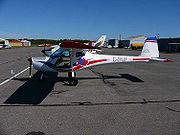 Typically, contemporary military pilots learn initial flying skills in a light aircraft not too dissimilar from civilian training aircraft. In this phase pilot candidates are screened for mental and physical attributes. Aircraft used for this purpose include the Slingsly Firefly
Typically, contemporary military pilots learn initial flying skills in a light aircraft not too dissimilar from civilian training aircraft. In this phase pilot candidates are screened for mental and physical attributes. Aircraft used for this purpose include the Slingsly Firefly
, as at one time used by the USAF Academy
, and the Scottish Aviation Bulldog
s of the RAF. The USAF replaced the Firefly and the Enhanced Flight Screen Program (EFSP) with the Diamond DA20
and the Initial Flight Screening (IFS) program. At the end of this stage pilot trainees are assessed as to where their attributes lie, as fast jet, multi-engine or rotary wing pilots. Those judged unsuitable for a pilot commission, but show other attributes may be offered the chance to qualify as navigators and weapons officers.
Smaller and more financially restricted air forces may use ultra-light aircraft
, gliders
and motor glider
s for this role.
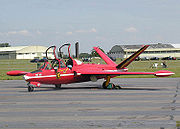
 After the ab-inito phase a candidate may progress to basic trainers/primary trainers. These are usually turboprop
After the ab-inito phase a candidate may progress to basic trainers/primary trainers. These are usually turboprop
trainers like the Pilatus PC-9
and Embraer Tucano
. Modern turbo-prop trainers can replicate the handling characteristics of jet aircraft as well as having sufficient performance to assess a candidate's technical ability at an aircraft controls, reaction speed and ability to anticipate events. Prior to the availability of high performance turboprops, basic training was conducted with jet aircraft such as the BAC Jet Provost
, T-37 Tweet, and Fouga Magister
. Those candidates who are not suitable to continue training as fast jet pilots may be offered flying commissions and train to fly multi-engined aircraft e.g. transport and tanker aircraft.
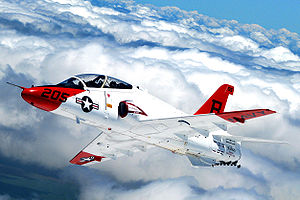 Those that progress to training for fast jet flying will then progress to an advanced trainer, typically capable of high subsonic speeds, high-energy manoeuvers, and equipped with systems that simulate modern weapons and surveillance. Examples of such jet trainer aircraft include the T-38 Talon
Those that progress to training for fast jet flying will then progress to an advanced trainer, typically capable of high subsonic speeds, high-energy manoeuvers, and equipped with systems that simulate modern weapons and surveillance. Examples of such jet trainer aircraft include the T-38 Talon
(actually capable of supersonic speeds), the BAE Hawk
, the Dassault/Dornier Alpha Jet and the Aero L-39
.
Effective combat aircraft are a function now of electronics as much as if not more so than the aerobatic ability or speed of an aircraft. It is at this stage that a pilot begins to learn to operate radar systems and electronics. Modern advanced trainers feature programmable multi-function displays which can be programmed to simulate different electronic systems and scenarios. Most advanced trainers do not have radar systems of their own, but onboard systems can be programmed to simulate radar contacts. With datalinks and GPS virtual radar systems can be created with similarly equipped aircraft relaying to each other their positions in real time and onboard computers creating a "Radar display
" based on this information. The aim of programmable displays is to speed pilot training by replicating as far as possible the systems a pilot will find in an operational aircraft.
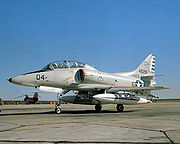 Most military ground-attack or interceptor aircraft have two-seat trainer versions. These are combat capable operational conversion aircraft types to provide "on the job training" to pilots who have graduated to this level, and are usually available with little conversion in times of emergency to a reconnaissance or combat role. There would be little point in having operational training aircraft that do not replicate fully the abilities of the operational aircraft, and most operational conversion aircraft retain the full functionality of the operational version with slight degradations to performance due to increased weight and drag, and possibly reduced range due to a reduced internal fuel load.
Most military ground-attack or interceptor aircraft have two-seat trainer versions. These are combat capable operational conversion aircraft types to provide "on the job training" to pilots who have graduated to this level, and are usually available with little conversion in times of emergency to a reconnaissance or combat role. There would be little point in having operational training aircraft that do not replicate fully the abilities of the operational aircraft, and most operational conversion aircraft retain the full functionality of the operational version with slight degradations to performance due to increased weight and drag, and possibly reduced range due to a reduced internal fuel load.
In some two seat fighter aircraft such as the Tornado, the OCU
aircraft can be created by duplicating flight controls in the rear cockpit. In normally single seat aircraft a second cockpit can be built behind the original cockpit (e.g. the TA-4S variant of the A-4SU Super Skyhawk) or the cockpit can be extended to place the instructor in a second seat behind the pilot. Once they have qualified in being able to fly a specific type of aircraft and have learned to use these aircraft to best effect, pilots will continue with regular training exercises to maintain qualifications on that aircraft and to improve their skills, for example the USAFs Red Flag exercises. Deployments of small flights of aircraft together with support staff and equipment to exercises conducted by other nations can be used to develop fighting skills and interservice and inter unit competitions in bombing and gunnery between units can also be used to develop those skills.
The two seat aircraft may itself become the basis of an operational aircraft, the second seat being used to create a weapons officer
/navigators station in aircraft with originally only a pilot, for example the F-15E Strike Eagle
is a development of the F-15D which is a two seat training version of the F-15 Eagle
.
In some air forces that have a mix of high and low performance aircraft, pilots can be first be assigned to aircraft with a lower level of performance before moving on to the most demanding aircraft. For example in the Italian Air Force a pilot may begin his service career on the AMX
attack aircraft, and as his experience grows progress to more capable aircraft such as the Tornado IDS
. Other air forces, such as Canada, do not do this and assign first-tour pilots to aircraft such as the CF-18 Hornet
.
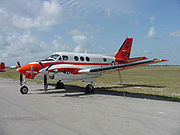 Those pilots who are destined to fly transports, tankers and other multi-engine aircraft begin with small multi-engine aircraft such as the T-44A Pegasus variant of the Beechcraft King Air
Those pilots who are destined to fly transports, tankers and other multi-engine aircraft begin with small multi-engine aircraft such as the T-44A Pegasus variant of the Beechcraft King Air
. Once they have mastered this they may begin to fly in the right hand seat of an operational type. Some airforces will seek to use a restricted number of multi-engined aircraft, with the derivatives of a basic aircraft filling different roles so that a pilot qualified on one of its types can easily convert to others in the same family. For example the Boeing 707
was a popular airliner for conversion to tanker, transport and ELINT variants by numerous air forces.
, Hawker Siddeley Dominie
or Boeing T-43
were developed from transport
designs to train navigators and other rear crews operators. As these navigational trainees are normally learning how to navigate using instruments, they can be seated at consoles within the aircraft cabin and do not require a direct view of the landscape over which the aircraft is flying. The operators of airborne weapons or radar
-related systems can be similarly trained, either in training aircraft or in an operational aircraft during training flights.
, Casa C-101, Folland Gnat
, Fouga Magister
and British Aerospace Hawk, are used by national formation aerobatic teams. Early jet aerobatic teams tended to use combat types such as the Hawker Hunter
, English Electric Lightning
, and North American F-100 Super Sabre
. As air forces' combat fleets were scaled-down, it made sense for most national display teams to change to lighter training types. A few modifications may be needed to enable coloured smoke to be emitted during displays, but essentially these airframes can still perform their pilot training function.
 In smaller air forces basic trainers, in addition to being used for training, are used as counter insurgency, airborne FAC
In smaller air forces basic trainers, in addition to being used for training, are used as counter insurgency, airborne FAC
and in the light strike/COIN role.
Most advanced trainers are capable of carrying and delivering war loads.
However most of these aircraft do not have the counter measures and sensors to survive alone in a modern high intensity war fighting scenario, for example being vulnerable to MANPADs. However they may still have a war fighting role in low intensity theatres, and if they operate in conjunction with more capable aircraft.
Historically many jet trainers were marketed with specialised attack variants e.g. the BAC Jet Provost
/BAC Strikemaster and the Cessna T-37 Tweet/A-37 Dragonfly
. Especially against opponents operating without a fighter screen or an effective anti-aircraft
capability, such trainer derived attack aircraft could perform adequately. For example Impala aircraft derived from the Aermacchi MB-326
trainer formed the main strike strength of the South African Air Force
in its Bush war
, and aircraft such as the Hongdu JL-8
are being acquired for the attack role in low intensity theatres.
Despite their vulnerability even small numbers of combat-equipped trainer aircraft in low-intensity theatres can have a disproportionate effect due to the surprise and shock of coming under air attack, especially when the attacked side believes itself to have a monopoly on air power. Forces that have used light trainer aircraft to great effect include the Biafra
n use of MFI-9
s and the Liberation Tigers of Tamil Eelam
use of covertly acquired light aircraft.
In high-intensity conflicts, advanced trainer type aircraft can have a military utility if they operate within a framework of other assets. For example the German and French Dassault/Dornier Alpha Jets had anti-shipping and light strike roles operating under an air umbrella provided by other aircraft, while the RAF planned to use pairs of gun- and AIM-9 Sidewinder
-armed Hawk trainers in the point defence role. Each pair of Hawks was to be teamed with a Phantom FGR.2
, in effect using the Phantoms as an Airborne Early Warning and Control system. Although never tested it was believed that the Hawk, combined with AIM-9L and flown by some of the best pilots in the RAF including those from the Red Arrows
, would have made a viable air defence fighter.
 As the capabilities of front line aircraft have increased this has been reflected in increasingly sophisticated advanced trainers. As the costs of developing new aircraft have risen in real terms, it has become more likely that fewer aircraft will be designed specifically for the training role. The advanced trainer was often seen as a stepping stone by most nations in developing a fast jet design and manufacturing capability. With increasing costs, even major air forces will have difficulty reaching the economies of scale to justify development of new advanced trainers. Nations will be required to continue to push the modernisation of existing aircraft (some such as the Hawk dating from the 1970s) or co-operate in the development and procurement of advanced training aircraft. Furthermore they must better utilise funding available by developing aircraft with an enhanced combat capability by producing operational single seat variants, and better utilise aircraft on inventory incorporating operational systems either within the aircraft or as external pods.
As the capabilities of front line aircraft have increased this has been reflected in increasingly sophisticated advanced trainers. As the costs of developing new aircraft have risen in real terms, it has become more likely that fewer aircraft will be designed specifically for the training role. The advanced trainer was often seen as a stepping stone by most nations in developing a fast jet design and manufacturing capability. With increasing costs, even major air forces will have difficulty reaching the economies of scale to justify development of new advanced trainers. Nations will be required to continue to push the modernisation of existing aircraft (some such as the Hawk dating from the 1970s) or co-operate in the development and procurement of advanced training aircraft. Furthermore they must better utilise funding available by developing aircraft with an enhanced combat capability by producing operational single seat variants, and better utilise aircraft on inventory incorporating operational systems either within the aircraft or as external pods.
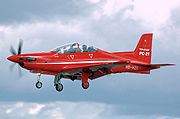 The trend of programmable electronic systems and datalinks is likely to continue with the possibility that ground based radar systems and processing systems will allow advanced training aircraft to function as if they truly had onboard radar systems, with the cockpit closely replicating the look and feel of an air forces more capable aircraft for maximum familiarity. Programmable engine management and fly-by-wire
The trend of programmable electronic systems and datalinks is likely to continue with the possibility that ground based radar systems and processing systems will allow advanced training aircraft to function as if they truly had onboard radar systems, with the cockpit closely replicating the look and feel of an air forces more capable aircraft for maximum familiarity. Programmable engine management and fly-by-wire
flight control systems will allow an aircraft to mimic the flight characteristics of frontline aircraft with actual performance being restricted to a pilot's level of ability, with more power and greater agility becoming available as a pilot's skill improves.
Training is now also carried out on ground-based simulators.
, the North American Texan
(Harvard in many countries) and the De Havilland Chipmunk.
Aircraft
An aircraft is a vehicle that is able to fly by gaining support from the air, or, in general, the atmosphere of a planet. An aircraft counters the force of gravity by using either static lift or by using the dynamic lift of an airfoil, or in a few cases the downward thrust from jet engines.Although...
designed specifically to facilitate in-flight training
Flight training
Flight training is a course of study used when learning to pilot an aircraft. The overall purpose of primary and intermediate flight training is the acquisition and honing of basic airmanship skills....
of pilots and aircrews. The use of a dedicated trainer aircraft with additional safety features—such as tandem flight controls, forgiving flight characteristics and a simplified cockpit arrangement—allows pilots-in-training to safely advance their real-time piloting, navigation and/or warfighting skills without the danger of overextending their abilities alone in a fully featured aircraft.
Civilian pilots are normally trained in a light aircraft, with 2 or more seats to allow for student and instructor. The aircraft may be modified to withstand the flight conditions imposed by training flights.
Tandem or side by side

It is now the norm for pilots to begin their flight training in an aircraft with side by side seating and to progress to aircraft with tandem seating. This however has not always been the case. For example, it was usual to find tandem seating in biplane basic trainers such as the Tiger Moth
De Havilland Tiger Moth
The de Havilland DH 82 Tiger Moth is a 1930s biplane designed by Geoffrey de Havilland and was operated by the Royal Air Force and others as a primary trainer. The Tiger Moth remained in service with the RAF until replaced by the de Havilland Chipmunk in 1952, when many of the surplus aircraft...
and the Jungmann
Bücker Bü 131
|-See also:-References:NotesBibliography* Bridgeman, Leonard. “The Bücker Bü 131B “Jungmann”.” Jane's Fighting Aircraft of World War II. London: Studio, 1946. ISBN 1-85170-493-0....
, and the British used side by side seating in the operational conversion of some of its fast jets such as the English Electric Lightning
English Electric Lightning
The English Electric Lightning is a supersonic jet fighter aircraft of the Cold War era, noted for its great speed and unpainted natural metal exterior finish. It is the only all-British Mach 2 fighter aircraft. The aircraft was renowned for its capabilities as an interceptor; Royal Air Force ...
.
Phases

Indian Air Force
The Indian Air Force is the air arm of the Indian armed forces. Its primary responsibility is to secure Indian airspace and to conduct aerial warfare during a conflict...
operated without a suitable advanced training aircraft, leading to a high casualty rate as pilots moved to high performance MiG 21 aircraft without suitable assessment of their aptitude for supersonic flight. In times of war the chances of victory increase with the quality of a pilot's training.
There are two main areas for instruction, flight training
Flight training
Flight training is a course of study used when learning to pilot an aircraft. The overall purpose of primary and intermediate flight training is the acquisition and honing of basic airmanship skills....
and operational training. In flight training a candidate seeks to develop their flying skills. In operational training the candidate learns to use his or her flying skills through simulated combat, attack and fighter techniques.
Ab initio

Slingsby T-67 Firefly
The Slingsby T67 Firefly, originally produced as the Fournier RF-6, is a two-seat aerobatic training aircraft, built by Slingsby Aviation in Kirkbymoorside, Yorkshire, England...
, as at one time used by the USAF Academy
United States Air Force Academy
The United States Air Force Academy is an accredited college for the undergraduate education of officer candidates for the United States Air Force. Its campus is located immediately north of Colorado Springs in El Paso County, Colorado, United States...
, and the Scottish Aviation Bulldog
Scottish Aviation Bulldog
|-See also:-External links:...
s of the RAF. The USAF replaced the Firefly and the Enhanced Flight Screen Program (EFSP) with the Diamond DA20
Diamond DA20
The Diamond DA20 is a two-seat tricycle gear general aviation aircraft designed for flight training. In addition to its role as a civil and military training aircraft, it is also used for personal flying by pilot-owners.-Development:...
and the Initial Flight Screening (IFS) program. At the end of this stage pilot trainees are assessed as to where their attributes lie, as fast jet, multi-engine or rotary wing pilots. Those judged unsuitable for a pilot commission, but show other attributes may be offered the chance to qualify as navigators and weapons officers.
Smaller and more financially restricted air forces may use ultra-light aircraft
Ultralight aviation
The term "ultralight aviation" refers to light-weight, 1- or 2-person airplanes., also called microlight aircraft in the UK, India and New Zealand...
, gliders
Glider (sailplane)
A glider or sailplane is a type of glider aircraft used in the sport of gliding. Some gliders, known as motor gliders are used for gliding and soaring as well, but have engines which can, in some cases, be used for take-off or for extending a flight...
and motor glider
Motor glider
A motor glider is a fixed-wing aircraft that can be flown with or without engine power. The FAI Gliding Commission Sporting Code definition is: A fixed wing aerodyne equipped with a means of propulsion ,...
s for this role.
Basic training


Turboprop
A turboprop engine is a type of turbine engine which drives an aircraft propeller using a reduction gear.The gas turbine is designed specifically for this application, with almost all of its output being used to drive the propeller...
trainers like the Pilatus PC-9
Pilatus PC-9
The Pilatus PC-9 is a single-engine, low-wing tandem-seat turboprop training aircraft manufactured by Pilatus Aircraft of Switzerland.-Design and development:...
and Embraer Tucano
Embraer EMB 312 Tucano
The Embraer EMB 312 Tucano is a two seat turboprop basic trainer developed in Brazil. The prototype first flew in 1980 and initial production units were delivered in 1983. The Tucano family of aircraft became one of Embraer's first international marketing successes, with 600 units produced...
. Modern turbo-prop trainers can replicate the handling characteristics of jet aircraft as well as having sufficient performance to assess a candidate's technical ability at an aircraft controls, reaction speed and ability to anticipate events. Prior to the availability of high performance turboprops, basic training was conducted with jet aircraft such as the BAC Jet Provost
BAC Jet Provost
The BAC Jet Provost was a British jet-powered trainer aircraft used by the Royal Air Force from 1955 to 1993. The Jet Provost was also successfully exported, serving in many air forces worldwide....
, T-37 Tweet, and Fouga Magister
Fouga Magister
The Fouga Magister is a 1950s French two-seat jet trainer. The related CM.175 Zéphyr was a carrier-capable version for the French Navy....
. Those candidates who are not suitable to continue training as fast jet pilots may be offered flying commissions and train to fly multi-engined aircraft e.g. transport and tanker aircraft.
Advanced training

T-38 Talon
The Northrop T-38 Talon is a twin-engine supersonic jet trainer. It was the world's first supersonic trainer and is also the most produced. The T-38 remains in service as of 2011 in air forces throughout the world....
(actually capable of supersonic speeds), the BAE Hawk
BAE Hawk
The BAE Systems Hawk is a British single-engine, advanced jet trainer aircraft. It first flew in 1974 as the Hawker Siddeley Hawk. The Hawk is used by the Royal Air Force, and other air forces, as either a trainer or a low-cost combat aircraft...
, the Dassault/Dornier Alpha Jet and the Aero L-39
Aero L-39
The Aero L-39 Albatros is a high-performance jet trainer aircraft developed in Czechoslovakia to meet requirements for a "C-39" during the 1960s to replace the L-29 Delfín...
.
Effective combat aircraft are a function now of electronics as much as if not more so than the aerobatic ability or speed of an aircraft. It is at this stage that a pilot begins to learn to operate radar systems and electronics. Modern advanced trainers feature programmable multi-function displays which can be programmed to simulate different electronic systems and scenarios. Most advanced trainers do not have radar systems of their own, but onboard systems can be programmed to simulate radar contacts. With datalinks and GPS virtual radar systems can be created with similarly equipped aircraft relaying to each other their positions in real time and onboard computers creating a "Radar display
Radar display
Modern radar systems typically use some sort of raster scan display to produce a map-like image. In the past, notably during the early days of radar development, such displays were difficult to produce for a number of reasons. Several different display types were developed during this...
" based on this information. The aim of programmable displays is to speed pilot training by replicating as far as possible the systems a pilot will find in an operational aircraft.
Lead-in fighter training
Lead-in fighter training (LIFT) utilises advanced jet trainer aircraft with avionics and stores-management capability that emulate operational fighter planes, to provide efficient training in combat scenarios with reduced training cost compared to moving straight to operational conversion. The on-board avionics system may be linked to ground-based systems, and together they can simulate situations such as infrared or radar guided missile, interceptors, air-to-air and surface-to-air missiles, anti-aircraft batteries, radars, chaff and flare countermeasures and collision warnings, in low or dense electronic warfare environments. Systems may also be able to re-enact true-to-life combat situations.Operational conversion

In some two seat fighter aircraft such as the Tornado, the OCU
Operational Conversion Unit
An Operational Conversion Unit is a unit within an air force whose role is to support preparation for the operational missions of a specific aircraft type by providing trained personnel. OCUs teach pilots how to fly an aircraft and which tactics best exploit the performance of their aircraft and...
aircraft can be created by duplicating flight controls in the rear cockpit. In normally single seat aircraft a second cockpit can be built behind the original cockpit (e.g. the TA-4S variant of the A-4SU Super Skyhawk) or the cockpit can be extended to place the instructor in a second seat behind the pilot. Once they have qualified in being able to fly a specific type of aircraft and have learned to use these aircraft to best effect, pilots will continue with regular training exercises to maintain qualifications on that aircraft and to improve their skills, for example the USAFs Red Flag exercises. Deployments of small flights of aircraft together with support staff and equipment to exercises conducted by other nations can be used to develop fighting skills and interservice and inter unit competitions in bombing and gunnery between units can also be used to develop those skills.
The two seat aircraft may itself become the basis of an operational aircraft, the second seat being used to create a weapons officer
Weapon systems officer
A Weapon Systems Officer is an air Flight Officer directly involved in all air operations and weapon systems of the fighter in the United States Navy. A Weapon Systems Officer ("WSO", pronounced "wizzo") is an air Flight Officer directly involved in all air operations and weapon systems of the...
/navigators station in aircraft with originally only a pilot, for example the F-15E Strike Eagle
F-15E Strike Eagle
The McDonnell Douglas F-15E Strike Eagle is an all-weather multirole fighter, derived from the McDonnell Douglas F-15 Eagle. The F-15E was designed in the 1980s for long-range, high speed interdiction without relying on escort or electronic warfare aircraft. United States Air Force F-15E Strike...
is a development of the F-15D which is a two seat training version of the F-15 Eagle
F-15 Eagle
The McDonnell Douglas F-15 Eagle is a twin-engine, all-weather tactical fighter designed by McDonnell Douglas to gain and maintain air superiority in aerial combat. It is considered among the most successful modern fighters with over 100 aerial combat victories with no losses in dogfights...
.
In some air forces that have a mix of high and low performance aircraft, pilots can be first be assigned to aircraft with a lower level of performance before moving on to the most demanding aircraft. For example in the Italian Air Force a pilot may begin his service career on the AMX
AMX International AMX
|-See also:-References:NotesBibliography*Braybrook, Roy. "Assessing the AMX". Air International, June 1989, Vol 36 No 6. Bromley, UK:Fine Scroll. ISSN 0306-5634. pp. 267–278....
attack aircraft, and as his experience grows progress to more capable aircraft such as the Tornado IDS
Panavia Tornado
The Panavia Tornado is a family of twin-engine, variable-sweep wing combat aircraft, which was jointly developed and manufactured by the United Kingdom, West Germany and Italy...
. Other air forces, such as Canada, do not do this and assign first-tour pilots to aircraft such as the CF-18 Hornet
CF-18 Hornet
The McDonnell Douglas CF-18 Hornet is a Royal Canadian Air Force fighter aircraft, based on the American McDonnell Douglas F/A-18 Hornet fighter. In 1980, the F/A-18 was selected as the winner of the New Fighter Aircraft competition, and a production order was awarded...
.
Multi-engine trainers

Beechcraft King Air
The Beechcraft King Air family is part of a line of twin-turboprop aircraft produced by the Beech Aircraft Corporation...
. Once they have mastered this they may begin to fly in the right hand seat of an operational type. Some airforces will seek to use a restricted number of multi-engined aircraft, with the derivatives of a basic aircraft filling different roles so that a pilot qualified on one of its types can easily convert to others in the same family. For example the Boeing 707
Boeing 707
The Boeing 707 is a four-engine narrow-body commercial passenger jet airliner developed by Boeing in the early 1950s. Its name is most commonly pronounced as "Seven Oh Seven". The first airline to operate the 707 was Pan American World Airways, inaugurating the type's first commercial flight on...
was a popular airliner for conversion to tanker, transport and ELINT variants by numerous air forces.
Navigation trainers
A minority of military training aircraft, such as the Vickers VarsityVickers Varsity
-See also:-References:NotesBibliography* Andrews, C.F. and E.B. Morgan. Vickers Aircraft since 1908. London: Putnam, 1988. ISBN 0-85177-815-1.* Ellis, Ken. Wrecks & Relics. Manchester, UK: Crecy Publishing, 21st edition, 2008. ISBN 9-780859-791342....
, Hawker Siddeley Dominie
British Aerospace BAe 125
The British Aerospace 125 is a twin-engined mid-size corporate jet, with newer variants now marketed as the Hawker 800. It was known as the Hawker Siddeley HS.125 until 1977...
or Boeing T-43
Boeing T-43
|-See also:-External links:* http://www.militaryaircraft.de/pictures/military/aircraft/T-43/T-43A_Gator.html* http://www.gruntsmilitary.com/t43a.shtml* http://www.globalsecurity.org/military/agency/usaf/12ftw.htm...
were developed from transport
Transport
Transport or transportation is the movement of people, cattle, animals and goods from one location to another. Modes of transport include air, rail, road, water, cable, pipeline, and space. The field can be divided into infrastructure, vehicles, and operations...
designs to train navigators and other rear crews operators. As these navigational trainees are normally learning how to navigate using instruments, they can be seated at consoles within the aircraft cabin and do not require a direct view of the landscape over which the aircraft is flying. The operators of airborne weapons or radar
Radar
Radar is an object-detection system which uses radio waves to determine the range, altitude, direction, or speed of objects. It can be used to detect aircraft, ships, spacecraft, guided missiles, motor vehicles, weather formations, and terrain. The radar dish or antenna transmits pulses of radio...
-related systems can be similarly trained, either in training aircraft or in an operational aircraft during training flights.
Aerobatic display teams
Some jet trainers, such as the Aermacchi MB-326Aermacchi MB-326
The Aermacchi or Macchi MB-326 is a light military jet aircraft designed in Italy. Originally conceived as a two-seat trainer, there have also been single and two-seat light attack versions produced. It is one of the most commercially successful aircraft of its type, being bought by more than 10...
, Casa C-101, Folland Gnat
Folland Gnat
The Folland Gnat was a small, swept-wing British subsonic jet trainer and light fighter aircraft developed by Folland Aircraft for the Royal Air Force, and flown extensively by the Indian Air Force....
, Fouga Magister
Fouga Magister
The Fouga Magister is a 1950s French two-seat jet trainer. The related CM.175 Zéphyr was a carrier-capable version for the French Navy....
and British Aerospace Hawk, are used by national formation aerobatic teams. Early jet aerobatic teams tended to use combat types such as the Hawker Hunter
Hawker Hunter
The Hawker Hunter is a subsonic British jet aircraft developed in the 1950s. The single-seat Hunter entered service as a manoeuvrable fighter aircraft, and later operated in fighter-bomber and reconnaissance roles in numerous conflicts. Two-seat variants remained in use for training and secondary...
, English Electric Lightning
English Electric Lightning
The English Electric Lightning is a supersonic jet fighter aircraft of the Cold War era, noted for its great speed and unpainted natural metal exterior finish. It is the only all-British Mach 2 fighter aircraft. The aircraft was renowned for its capabilities as an interceptor; Royal Air Force ...
, and North American F-100 Super Sabre
F-100 Super Sabre
The North American F-100 Super Sabre was a supersonic jet fighter aircraft that served with the United States Air Force from 1954 to 1971 and with the Air National Guard until 1979. The first of the Century Series collection of USAF jet fighters, it was the first USAF fighter capable of...
. As air forces' combat fleets were scaled-down, it made sense for most national display teams to change to lighter training types. A few modifications may be needed to enable coloured smoke to be emitted during displays, but essentially these airframes can still perform their pilot training function.
Combat use of trainers

Forward air control
Forward air control is the provision of guidance to Close Air Support aircraft intended to ensure that their attack hits the intended target and does not injure friendly troops. This task is carried out by a forward air controller . For NATO forces the qualifications and experience required to be...
and in the light strike/COIN role.
Most advanced trainers are capable of carrying and delivering war loads.
However most of these aircraft do not have the counter measures and sensors to survive alone in a modern high intensity war fighting scenario, for example being vulnerable to MANPADs. However they may still have a war fighting role in low intensity theatres, and if they operate in conjunction with more capable aircraft.
Historically many jet trainers were marketed with specialised attack variants e.g. the BAC Jet Provost
BAC Jet Provost
The BAC Jet Provost was a British jet-powered trainer aircraft used by the Royal Air Force from 1955 to 1993. The Jet Provost was also successfully exported, serving in many air forces worldwide....
/BAC Strikemaster and the Cessna T-37 Tweet/A-37 Dragonfly
A-37 Dragonfly
The Cessna A-37 Dragonfly, or Super Tweet, is a United States light attack aircraft developed from the T-37 Tweet basic trainer in the 1960s and 1970s...
. Especially against opponents operating without a fighter screen or an effective anti-aircraft
Anti-aircraft warfare
NATO defines air defence as "all measures designed to nullify or reduce the effectiveness of hostile air action." They include ground and air based weapon systems, associated sensor systems, command and control arrangements and passive measures. It may be to protect naval, ground and air forces...
capability, such trainer derived attack aircraft could perform adequately. For example Impala aircraft derived from the Aermacchi MB-326
Aermacchi MB-326
The Aermacchi or Macchi MB-326 is a light military jet aircraft designed in Italy. Originally conceived as a two-seat trainer, there have also been single and two-seat light attack versions produced. It is one of the most commercially successful aircraft of its type, being bought by more than 10...
trainer formed the main strike strength of the South African Air Force
South African Air Force
The South African Air Force is the air force of South Africa, with headquarters in Pretoria. It is the world's second oldest independent air force, and its motto is Per Aspera Ad Astra...
in its Bush war
South African Border War
The South African Border War, commonly referred to as the Angolan Bush War in South Africa, was a conflict that took place from 1966 to 1989 in South-West Africa and Angola between South Africa and its allied forces on the one side and the Angolan government, South-West Africa People's...
, and aircraft such as the Hongdu JL-8
Hongdu JL-8
The Hongdu JL-8 is a two-seat intermediate jet trainer and light attack aircraft designed in the People's Republic of China by China Nanchang Aircraft Manufacturing Corporation. The primary contractor for this plane is the Hongdu Aviation Industry Corporation...
are being acquired for the attack role in low intensity theatres.
Despite their vulnerability even small numbers of combat-equipped trainer aircraft in low-intensity theatres can have a disproportionate effect due to the surprise and shock of coming under air attack, especially when the attacked side believes itself to have a monopoly on air power. Forces that have used light trainer aircraft to great effect include the Biafra
Biafra
Biafra, officially the Republic of Biafra, was a secessionist state in south-eastern Nigeria that existed from 30 May 1967 to 15 January 1970, taking its name from the Bight of Biafra . The inhabitants were mostly the Igbo people who led the secession due to economic, ethnic, cultural and religious...
n use of MFI-9
Malmö MFI-9
|-See also:-References:* -External links:*...
s and the Liberation Tigers of Tamil Eelam
Liberation Tigers of Tamil Eelam
The Liberation Tigers of Tamil Eelam was a separatist militant organization formerly based in northern Sri Lanka. Founded in May 1976 by Vellupillai Prabhakaran, it waged a violent secessionist and nationalist campaign to create an independent state in the north and east of Sri Lanka for Tamil...
use of covertly acquired light aircraft.
In high-intensity conflicts, advanced trainer type aircraft can have a military utility if they operate within a framework of other assets. For example the German and French Dassault/Dornier Alpha Jets had anti-shipping and light strike roles operating under an air umbrella provided by other aircraft, while the RAF planned to use pairs of gun- and AIM-9 Sidewinder
AIM-9 Sidewinder
The AIM-9 Sidewinder is a heat-seeking, short-range, air-to-air missile carried mostly by fighter aircraft and recently, certain gunship helicopters. The missile entered service with United States Air Force in the early 1950s, and variants and upgrades remain in active service with many air forces...
-armed Hawk trainers in the point defence role. Each pair of Hawks was to be teamed with a Phantom FGR.2
F-4 Phantom II non-U.S. operators
F-4 Phantom II non-U.S. operators are the non-U.S. nations with air forces that operate or used to operate the McDonnell Douglas F-4 Phantom II. The Phantom II entered service with the U.S. military in 1960 and served until 1996. During this time it was the primary interceptor, air superiority...
, in effect using the Phantoms as an Airborne Early Warning and Control system. Although never tested it was believed that the Hawk, combined with AIM-9L and flown by some of the best pilots in the RAF including those from the Red Arrows
Red Arrows
The Red Arrows, officially known as the Royal Air Force Aerobatic Team, is the aerobatics display team of the Royal Air Force based at RAF Scampton, but due to move to RAF Waddington in 2011...
, would have made a viable air defence fighter.
The future


Fly-by-wire
Fly-by-wire is a system that replaces the conventional manual flight controls of an aircraft with an electronic interface. The movements of flight controls are converted to electronic signals transmitted by wires , and flight control computers determine how to move the actuators at each control...
flight control systems will allow an aircraft to mimic the flight characteristics of frontline aircraft with actual performance being restricted to a pilot's level of ability, with more power and greater agility becoming available as a pilot's skill improves.
Training is now also carried out on ground-based simulators.
Historical
Classic training types were the De Havilland Tiger MothDe Havilland Tiger Moth
The de Havilland DH 82 Tiger Moth is a 1930s biplane designed by Geoffrey de Havilland and was operated by the Royal Air Force and others as a primary trainer. The Tiger Moth remained in service with the RAF until replaced by the de Havilland Chipmunk in 1952, when many of the surplus aircraft...
, the North American Texan
T-6 Texan
The North American Aviation T-6 Texan was a single-engine advanced trainer aircraft used to train pilots of the United States Army Air Forces, United States Navy, Royal Air Force and other air forces of the British Commonwealth during World War II and into the 1950s...
(Harvard in many countries) and the De Havilland Chipmunk.

